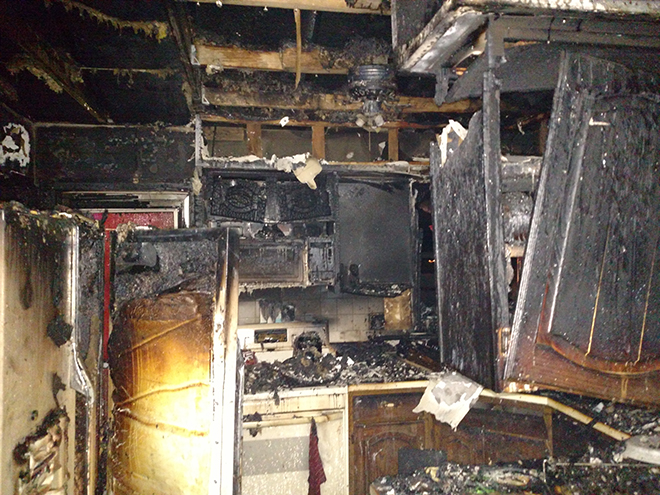BFD wants to know if you have renters insurance

This kitchen fire destroyed all the appliances and everything in the cabinets. Renters insurance would have paid to replace them, covered liability for structural damage, and (depending on the insurance) somewhere to stay for a day or two.
By Anne Eickstadt
Editor
“It breaks our hearts,” said Chief Al Hyser, “when we have put out a fire in an apartment and the residents look at us and say, ‘What do we do now? Where do we go?’ They have just lost everything and had no insurance to protect them.”
“In the last three apartment fires that Belvidere Fire Department has responded to, the residents didn’t have renters insurance and in one case they didn’t even know there was such a thing,” said Lt. Chad Cunningham. “Also some renters think that the landlord’s insurance on the building covers their items and that isn’t true.
Only 37 percent of renters have renter’s insurance whereas 95 percent of homeowners have a homeowner’s insurance policy.
“I have done some research on the cost of renters insurance and was able to find out a few things. I checked some online companies and then called three different Belvidere based insurance companies and asked pretty much the same questions. “Below are some facts and the information I found:
-The criteria was the same for all. It was based on a 40-year-old person living in an apartment. The coverage amount was an average of $25,000.
-The two online websites were getcertainly.com and lemonade.com. It was very easy to check them out online. I could have had coverage in less than 10 minutes for around $10 a month.
-The three local insurance agents I called were in the same ballpark.
“I would recommend that individuals needing insurance contact their auto insurance provider and get an add-on policy. They may receive a 10 to 15 percent discount on their auto insurance and, in some cases, the savings would cover the cost of the insurance. The average was also around $10 a month for approximately $25,000 in coverage. If the resident does not have insurance somewhere already, I recommend that they make some calls and shop around for the best price for their situation.”
The Insurance.illinois.gov/Consumer/RentersinsuranceHelp website says this about renters insurance:
Renters face many of the same risk as homeowners. Your landlord may have insurance, but it only protects the building structure, not your personal property. Renters insurance can protect your belongings in case of disaster. Liability protection is also standard with most renters’ policies for the possibility that your landlord decides to sue you for damages.
How much renters insurance do you need?
Talk to your insurance agent or company about the property you want to protect and the property hazards you would like to be insured from. Your agent can give you coverage policy specifics based on your state and the type of policy you want. They will answer any important questions you have about:
-What hazards are included in your plan and if you need a separate policy for specific circumstances
-If your insurance plan affects your roommate(s), if any
-How you should determine value for your items
-What some of the insurance terms mean or what they include
-What optional coverage might be available to you
-How much liability coverage is included in your plan
Actual cash value vs. replacement cost
-“Actual cash value” (ACV) coverage will pay only what your property was worth at the time it was damaged or stolen. So, if you bought a television five years ago for $500, it would be worth significantly less today. While you’d still need to spend about $500 for a new TV, your insurance company will pay only what the old one is worth, minus your deductible.
-Replacement cost coverage will pay what it actually costs to replace the items you lost, minus the deductible. Replacement cost coverage will have a higher premium, but it will pay out more if you ever need to file a claim.
Creating a home inventory
A home inventory, along with photos and proof of ownership, make it easier to file an accurate insurance claim in case your home is damaged or destroyed. A home inventory can also help determine how much coverage you need from your renter’s insurance.
-Group your possessions into logical categories, i.e., by hobby, by room in your home, etc.
-Your list should include special purchases like jewelry and art, as well as everyday leisure items such as televisions and guitars.
-Don’t forget items that are used rarely such as holiday decorations, sports equipment, tools, etc.
-Pull together copies of original sales receipts and/or appraisal documents. Also note model and serial numbers.
-Carefully photograph or videotape each item and document a brief description, including age, purchase price and estimated current value.
-Store your home inventory and related documents in a safe, easily accessible place online, on your computer or in a fireproof box or safe deposit box. Consider sharing a copy with friends, relatives and your insurance provider.
iPhone users — The NAIC’s free downloadable app, myHome Scr.App.book, lets you quickly photograph and capture descriptions of your possessions room by room, then store electronically for safekeeping.
Android users — With the home inventory app, myHome Scr.App.book, you can quickly capture images, descriptions, and serial numbers of your possessions, then organize the information by room or by category. The app even creates a back-up file for email sharing.
For further information, you can check out your insurance company’s website for renter’s insurance, call your insurance agent, and/or compare prices online to get the best value for the protection that renter’s insurance provides.



